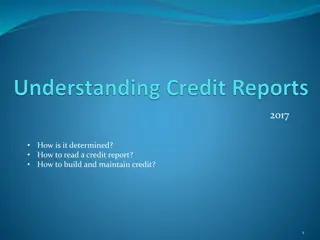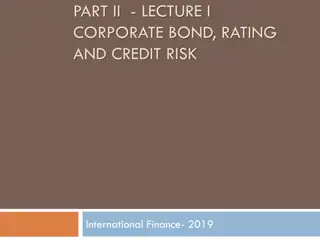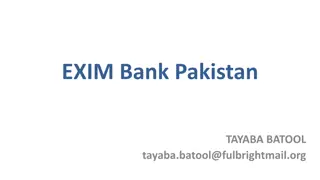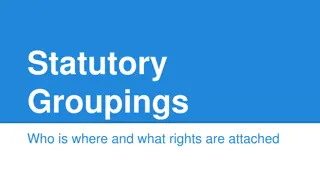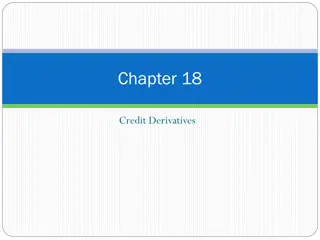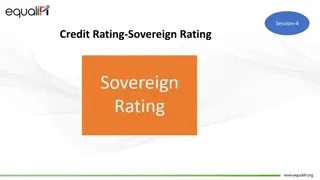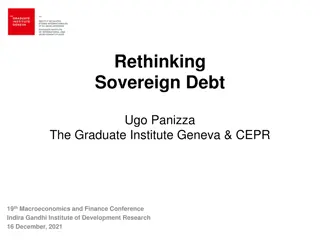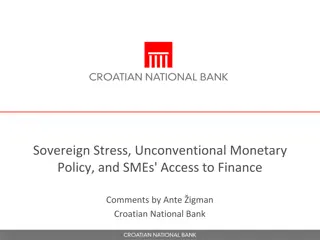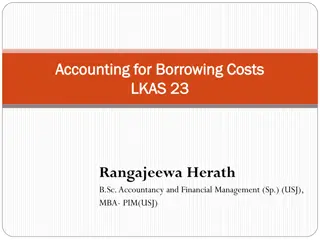Insights on Sovereign Credit Ratings: A Study on European Countries' Borrowing Costs
This paper discusses the impact of sovereign credit ratings on European countries' borrowing costs, emphasizing that while ratings do affect costs, the influence is limited except at junk thresholds. It identifies macro fundamentals and global risk as key determinants of credit ratings and suggests that ratings agencies have a minor, albeit potentially significant, meddling role.
- Sovereign credit ratings
- European countries
- Borrowing costs
- Credit rating agencies
- Macro fundamentals
Download Presentation

Please find below an Image/Link to download the presentation.
The content on the website is provided AS IS for your information and personal use only. It may not be sold, licensed, or shared on other websites without obtaining consent from the author. Download presentation by click this link. If you encounter any issues during the download, it is possible that the publisher has removed the file from their server.
E N D
Presentation Transcript
Comments on Davor Kunovac and Rafael Ravnik s Are sovereign credit ratings overrated? Nauro Campos Brunel University London For presentation at The 22nd Dubrovnik Economic Conference June 12 2016
2 caveats to start I will comment on the paper, not on the presentation (which as you could see was excellent) I really liked the paper a lot (but I don t teach/write about sovereign ratings) (BTW great title!) 2
What does the paper do? 4 Q (1) do (sovereign credit) ratings affect (borrowing) costs (of European countries)?
What does the paper finds? (1) do (sovereign credit) ratings affect (borrowing) costs (of European countries)? Answer: yes, not much but when junk threshold
What does the paper do? (1) do (sovereign credit) ratings affect (borrowing) costs (of European countries)? (2) what determines credit ratings (EU membs)?
What does the paper finds? (1) do (sovereign credit) ratings affect (borrowing) costs (of European countries)? Answer: yes, not much but when junk threshold (2) what determines credit ratings (EU membs)? Answer: macro fund tals and global risk
What does the paper do? (1) do (sovereign credit) ratings affect (borrowing) costs (of European countries)? (2) what determines credit ratings (EU membs)? (3) how much ratings agencies meddle ?
What does the paper finds? (1) do (sovereign credit) ratings affect (borrowing) costs (of European countries)? Answer: yes, not much but when junk threshold (2) what determines credit ratings (EU membs)? Answer: macro fund tals and global risk (3) how much ratings agencies meddle ? Answer: little (but is 10% really little?)
What does the paper do? (1) do (sovereign credit) ratings affect (borrowing) costs (of European countries)? (2) what determines credit ratings (EU membs)? (3) how much ratings agencies meddle ? (4) do markets do it better?
What does the paper finds? (1) do (sovereign credit) ratings affect (borrowing) costs (of European countries)? Answer: yes, not much but when junk threshold (2) what determines credit ratings (EU membs)? Answer: macro fund tals and global risk (3) how much ratings agencies meddle ? Answer: little (but is 10% really little?) (4) do markets do it better? Answer: of course, markets always do it better
I have three main comments and many tiny ones Main number 1 is this: You must deal properly with what you (perhaps mistakenly) call political factors In each of the four exercises, there is a suggestion that this is a key omitted variable or worse A suggestion: Nick Bloom s Economic Policy Uncertainty Index (http://www.policyuncertainty.com/index.html)
Main comment 2 Advice for whole paper: Croatia is mentioned 3 times in the first paragraph Why an Estonian/Spaniard/Californian who is reading this paper should be interested in Croatia? Instead use country studies to illustrate regression results Hw? Compare Croatia with Hungary and UK
Main comment 3 Make sure you provide estimation details Which estimator is being used? Number of observations???? How are ratings being used/entering the regressions? All 3 agencies together? What s the correlation?
Introduction Currently, written as an executive summary There are no references (academic/not) until page 6 1.1 Selected lit review, can it become a proper section? (pls cite a couple of surveys)
Section 2 Role of Rating Agencies Summarise in one paragraph And move the rest to an appendix I imagine people that started to read this paper have an idea about what ratings agencies do
Section 3 (exercise 1, q1) Needs major clarifications 23 EU countries, why/what happens the missing 5? Are stock prices measures of BC at daily freq ? All 3 agencies together? Correlation? Agencies job is to be Arbiter of Junk: discuss fully What estimator? Number of observations?
Section 4 (exercise 2, q2) One year moving average for daily obs? Is this std? At least Hausman test Economic freedom vs Doing Biz is problematic, cf policy uncertainty index Footnote 11: please fix: where is Table 8? Where are columns V and VI? Needs major clarifications Number of obs? Use country studies to illustrate regression results: add to Croatia discussion (p19), eg Hungary and UK
Section 5 (exercise 3, q3) The decomposition should be presented in a more careful and clear way Maybe a technical appendix? Use country studies to illustrate regression results: add to Croatia discussion (p23), eg Hungary and UK Number of obs?
Section 6 (exercise 4, q4) Rating agencies wrt market are delayed TWO years! How does this compare to rest of lit? Use country studies to illustrate regression results: add to Croatia discussion (p23), eg Hungary and UK More details of estimation? Number of obs? PS Need to write proper Conclusion section
In summary I really liked the paper A number of interesting results 1) Major issues: lack of policy uncertainty measure 2) More details on estimation 3) More illustration of regression results using country case studies (Croatia, Hungary and UK)








